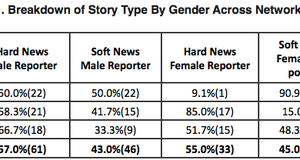|
From Elon Journal of Undergraduate Research in Communications VOL. 5 NO. 1 Revolutionizing the Newsroom: How Online and Mobile Technologies Have Changed Broadcast Journalism
By Nicole Chadwick
Elon Journal of Undergraduate Research in Communications
2014, Vol. 5 No. 1 | pg. 2/3 | « »
As a result of online and mobile news, big changes happened to content production in the newsroom. Matt Howerton, reporter at KWTX in Waco, Texas, called it a “balancing act,” explaining that having to focus on the online and mobile content makes for a much more complicated day for local journalists.31 But, some stations have taken advantage of the online and mobile audience and created useful content opportunities for the reporter as well as the audience. At WVEC-TV in Norfolk, the reporters post a “mobile minute” for every story they write, producing 30-45 seconds of video and audio content for their increasing mobile audience. And Nick Ochsner, reporter at WVEC, believes it helps him improve as a journalist as well as provide more content for the audience. “It’s a great tool during breaking news events where there’s constantly new information to share,” he said. “Instead of having to wait until the five o’clock broadcast or add new copy to a web article, I can shoot a new mobile minute that shows whatever new action is unfolding.”32 Kirsten Boyd, producer at KOAA-TV in Colorado Springs has seen how online and mobile tools can save lives during natural disasters. “During the Waldo Canyon and Black Forest wildfires, there was an official hashtag that emergency managers were using to share information on spread, containment, road closures and evacuations,” she said. “Twitter is critical for news gathering and we all monitor it by the minute for information.”
In addition, news distribution speed has increased dramatically. But, many of the journalists in this study warned about the problem of the fast paced online news cycle. Being first can sometimes come at the expense of being accurate.33
It is important to recognize the fact that Twitter and Reddit are not sources of news, they are sources of “information,” and also, more to the point, speculation. It is very, very dangerous to look to Twitter for real information because anybody anywhere can tweet anything regardless of the truth. The race to be first is not worth being wrong, though there is a competitive edge to many people who work in the news business, so that is a lesson that some people end up learning the hard way. -Andy Merlis, Producer, CBS This Morning34
To adapt to a changing work environment, many newsrooms have added a digital media team, a group of people hired to produce and manage online content, which has become the norm in many local stations and at the network level. Drew Smith, a reporter at WSPA-TV in Spartanburg, South Carolina, believes the digital team is an integral part of the newsgathering and dissemination process of information. The station’s digital media team uses real time analytics to see viewing habits that have not been available even with sophisticated sampling and statistical analysis from companies like Nielsen. The newsroom is able to see how many people are online at once, what stories people are viewing, and how they got there. “It helps us figure out what’s important to viewers and it helps the business side of things when determining the value of our product,” Smith said.35
Though online and mobile news have produced many benefits for the news industry, they have also brought challenges. One main challenge is the change to the daily workflow for journalists, particularly multimedia or one-man-band journalists36. Across all market sizes, the trend toward hiring multimedia journalists or “one-man bands” who report, shoot, write and edit, shows no sign of slowing (see Figure 1)37. “Shooting, editing, writing and tracking a package is such a time consuming process,” Howerton of KWTX said. “Adding web and mobile updates is like adding more weight to a barbell you’re dead lifting.”38 Time management becomes even more important to the journalist than it was before online and mobile technology.39 Journalists must keep people interested and present information the audience has not heard, which is difficult with the younger demographic.40 41
Another prominent change is that once stories air, they are no longer “in the aether.” Stories are shared and instantly put up online for viewer access. One editorial producer said:
In the 1970s, when I began my career, first at local news and then at CBS, stories aired and that was it. If you missed it, you missed it. There was no DVR, no on-Demand, no “web-extra”, no YouTube, no Internet at all. In the mid to late 70’s few people even owned recording devices. No one recorded shows. You watched when it was on.
What this means is that now journalists need to be extra careful, not only with the information they report but with the visuals they choose. Segments can be looked at and listened to again and again, frames frozen, zoomed in, and scrutinized. People look for inaccuracies – from factual errors to misleading pictures and interviews. And they “share” their finds instantly with everyone, via Twitter, YouTube and other social media. Mistakes made in the past generally resulted in thoughtful, sometimes angry, letters to the editor. Comments and mistakes now go global. -Cathy Lewis, Editorial Producer, CBS Sunday Morning42
It is clear from these comments that newsrooms have changed workflow, culture, job opportunities, and managerial processes due to the introduction of online and mobile news. The final question of this study asked professionals to predict what will happen in the future of television news.

Figure 1. 2013 STATE OF THE NEWS MEDIA, from Pew Research Center
Every journalist in this study believes there will still be a place for newscasts in the future, but the word “traditional” may no longer be associated with them. The newsrooms are already adapting to an idea of an “interactive newscast,” where viewers can not only see the newscast from multiple cameras to see how the process works, but also chat with anchors and reporters live during the newscast. Television stations are embracing ways to include new technology in the newscast, and that will continue as long as technology changes.43 Monica Yantosh, reporter at KLBK in Lubbock, Texas, observed television newscasts will still exist in small towns because many people still only have access to broadcast television and not the Internet.44 Audiences are invested in their local and national anchors, trusting them for information, but also regarding them as friends, helping traditional newscasts to continue to succeed.45 But, the success of television journalism across the country will continue to depend on adaptations to new technology.46
The mainstream news outlets must continue to provide more avenues for audience members to access content. “There is still a large market for old media, not just older people,” Lewis of Sunday Morning said. “While young people do tend to get the majority of their news and information online, many still watch the old fashioned way, as evidenced by CBS Sunday Morning’s steadily increasing ratings among adults age twenty-five to fifty-four, the demographic that matters most to advertisers.”47
On the network level, producers are exploring ways to produce original content programming for video streaming services like Netflix and Amazon. Zirinsky of 48 Hours predicts there will be an increase in competition for original digital programming in the future as more and more television production is published online. This competition, however, will create a new business model rather than a replacement of the traditional newscast.48 Television stations and shows are made stronger by their online and mobile presence because it allows them to connect with the younger demographic.49 Many people believed in the past that the introduction of radio would replace newspapers, that the introduction of television would replace radio, and that the Internet would replace all of them.50 But the professionals interviewed believe television newscasts cannot be replaced by new technology, rather the new technology will add to their audience’s experience.51 52 53 The future of television journalism fluctuates and changes every day based on the introduction of and changes in technology. Successful adaptation to new forms, like applications and “mobile minutes,” and enhancing old ones, like creating the interactive newscast, can keep television news alive and successful in the future.Continued on Next Page »
Bardoel, Jo, Deuze, Mark, “Network Journalism: Converging Competences of Media Professionals and Professionalism,” Australian Journalism Review (2001): 23 pp.91-103.
Deuze, Mark, “Online Journalism: Modeling the first generation of news media on the world wide web” Peer Reviewed Journal on the Internet (2001).
Dooley, Patricia. The Technology of Journalism: Cultural Agents, Cultural Icons (Northwestern University: Northwestern University Press, 2007).
Giles, Robert and Snyder, Robert W. Problems & Prospects of Journalism: What’s Next? (New Brunswick: Transaction Publishers, 2001).
Jenkins, Henry. “Convergence: I Diverge.” MIT Technology Review, June 1, 2001.
Jurkowitz, Mark and Matsa, Katerina Eva, “Despite Some Warning Signs, Local TV Stations Are Hot Commodities,” Pew Research Journalism Project, August 5, 2013, accessed October 15, 2013, http://www.journalism.org/2013/08/05/despite-some-warning-signs-local-tv-stations-are-hot-commodities/
Nguyen, An “The current status and potential development of online news consumption: a structural approach” First Monday, 2001, http://firstmonday.org/ojs/index.php/fm/article/view/1075/995(October 15, 2013)
Sasseen, Jane, Olmstead, Kenny, and Mitchell, Amy “Digital: As Mobile Grows Rapidly, the Pressures on News Intensify,” The State of the News Media 2013, accessed October 15, 2013, http://stateofthemedia.org/2013/digital-as-mobile-grows-rapidly-the-pressures-on-news-intensify/
Endnotes
- Patricia L. Dooley, The Technology of Journalism: Cultural Agents, Cultural Icons (Northwestern University: Northwestern University Press, 2007). 1.
- Giles, Snyder, What’s Next?, xi.
- Susan Zirinksy, Executive Producer, 48 Hours, in a telephone interview with the author, November 1, 2013.
- Mark Effron, “Broadcast Journalism Not Dead, Just Changing,” TV Week, 2010, http://www.tvweek.com/news/2008/07/guest_commentary_broadcast_jou.php (November 12, 2013).
- John Naughton, A Brief History of the Future: The Origins of the Internet (Great Britain: Weidenfeld & Nicolson, 1999), 22.
- Jo Bardoel and Mark Deuze, “Network Journalism: Converging Competences of Media Professionals and Professionalism,” Australian Journalism Review (2001), 23.
- Mark Deuze, “Online Journalism: Modeling the first generation of news media on the world wide web” First Monday (2001).
- Henry Jenkins, “Convergence: I Diverge.” MIT Technology Review, June 1, 2001
- Robert Giles and Robert W. Snyder, Problems & Prospects of Journalism: What’s Next? (New Brunswick: 2001), xi.
- Mark Jurkowitz and Katerina Eva Matsa, “Despite Some Warning Signs, Local TV Stations Are Hot Commodities,” Pew Research Journalism Project, August 5, 2013 http://www.journalism.org/2013/08/05/despitesome-warning-signs-local-tv-stations-are-hot-commodities/ (October 15, 2013).
- Jane Sasseen, Kenny Olmstead, and Amy Mitchell,“Digital: As Mobile Grows Rapidly, the Pressures on News Intensify,” The State of the News Media 2013, 2013, http://stateofthemedia.org/2013/digital-as-mobilegrows-rapidly-the-pressures-on-news-intensify/, (October 15, 2013).
- Dapzury Valenzuela and Pallavi Shrivastava, Interview as a Method for Qualitative Research, Southern Cross University and the Southern Cross Institute of Action Research.
- Steinar Kvale, InterViews: An Introduction to Qualitative Research Interviewing, Sage Publications, 1996.
- Matt Howerton, in a Facebook message to the author, October 16, 2013.
- Drew Smith, reporter in an email message to the author, October 19, 2013.
- Reporters write the stories for the newscast including parts of interviews and research into their content. Also see one-man band.
- Print style is a form of writing an article that is written generally for the web or for a newspaper in Associated Press style.
- Janet St. James, in an email message to the author, October 17, 2013
- Nick Ochsner, in a Facebook message to the author, October 16, 2013.
- Monica Yantosh, in a Facebook message to the author, November 5, 2013.
- Producers work with reporters, associate producers, and the executive producers to write and put together content for individual stories and/or for a cohesive newscast.
- B-roll is the supplemental or alternate footage intercut with the main shot in an interview or documentary.
- Andy Merlis, in an email message to the author, October 21, 2013.
- Cathy Lewis, in an email message to the author, October 31, 2013.
- Meggie Miao, in an email message to the author, October 23, 2013.
- Kenneth Olmstead, Mark Jurkowitz, Amy Mitchell and Jodi Enda, “How Americans Get TV News at Home,” Pew Research Journalism Project, 2013, November 10, 2013.
- Zirinsky, telephone conversation with the author.
- Shelly Slater, in an email message to the author, October 22, 2013.
- Amy Mitchell, Jocelyn Kiley, Jeffrey Gottfried and Emily Guskin, “The Role of News on Facebook: Common yet Incidental,” Pew Journalism Project, 2013, http://www.journalism.org/2013/10/24/the-role-of-news-onfacebook/, (November 10, 2013).
- Sasseen, Olmstead, and Mitchell, The State of the News Media 2013, 2013.
- Howerton, Facebook message to the author.
- Ochsner, Facebook message to the author.
- St. James, email to the author.
- Merlis, email to the author.
- Smith, Facebook message to the author.
- One-man-band journalists are journalists that write their own content, do their own research, and shoot and edit their own video for the air.
- Deborah Potter, Katerina-Eva Matsa and Amy Mitchell, “Local TV: Audience Declines as Revenue Bounces Back,” The State of the News Media 2013, 2013.
- Howerton, Facebook message to the author.
- Yantosh, Facebook message to the author.
- Slater, email to the author.
- Samuels, email to the author.
- Lewis, email to the author.
- Smith, Facebook message to the author.
- Yantosh, Facebook message to the author.
- Boyd, Facebook message to the author.
- Howerton, Facebook message to the author.
- Lewis, email to the author.
- Zirinsky, telephone conversation with the author.
- Miao, email to the author.
- Zirinsky, telephone conversation with the author.
- Slater, email to the author.
- Zirinsky, telephone conversation with the author.
- Ochsner, Facebook message to the author.
Save Citation » (Works with EndNote, ProCite, & Reference Manager)
APA 6th
Chadwick, N. (2014). "Revolutionizing the Newsroom: How Online and Mobile Technologies Have Changed Broadcast Journalism." Elon Journal of Undergraduate Research in Communications, 5(1). Retrieved from http://www.inquiriesjournal.com/a?id=969
MLA
Chadwick, Nicole. "Revolutionizing the Newsroom: How Online and Mobile Technologies Have Changed Broadcast Journalism." Elon Journal of Undergraduate Research in Communications 5.1 (2014). <http://www.inquiriesjournal.com/a?id=969>
Chicago 16th
Chadwick, Nicole. 2014. Revolutionizing the Newsroom: How Online and Mobile Technologies Have Changed Broadcast Journalism. Elon Journal of Undergraduate Research in Communications 5 (1), http://www.inquiriesjournal.com/a?id=969
Harvard
CHADWICK, N. 2014. Revolutionizing the Newsroom: How Online and Mobile Technologies Have Changed Broadcast Journalism. Elon Journal of Undergraduate Research in Communications [Online], 5. Available: http://www.inquiriesjournal.com/a?id=969
Suggested Reading from Inquiries Journal
Recent advancements in digital media have had drastic effects on magazines across the country. This research paper addressed those results by examining the digital and social media practices of four city magazines based in the American Southeast to determine what practices are working across social media and digital platforms. Through... MORE»
Twitter. Facebook. Digg. MySpace. LinkedIn. The list of social media tools could probably run on for paragraphs, and today’s technology changes so rapidly that many industries, including corporations and news media... MORE»
This study, conducted during a two-week period leading up to the 2012 Presidential Election, analyzed three prime time news broadcasts to determine whether male journalists reported more hard news stories than female journalists throughout a segment of increased political activity and whether male and female sources were used equally... MORE»
The simplistic history of modern journalism commonly disseminated in western classrooms describes literary journalism and its manifestations around the world as traceable back to a single Anglo-American tradition —... MORE»
Latest in Business & Communications
2021, Vol. 13 No. 09
This research lies at the nexus of political communication theory relating to emotional affect and political processing and the burgeoning field of sentiment analysis. News coverage can affect opinion both through the information it provides and... Read Article »
2021, Vol. 13 No. 06
This research study explores factors that present barriers to reporting workplace incidents and contribute to cultures of non-report. The research purpose was to explore human, workplace/organizational, and external factors identified by industrial... Read Article »
2016, Vol. 8 No. 11
In its beta release, Google Glass was positioned as a groundbreaking technology - a glimpse into a future that has long been promised in science fiction. It was met with media fanfare and consumer interest, despite costing more than most PCs on... Read Article »
2016, Vol. 7 No. 1
Predicting the future of the news industry begins with understanding the history of newspapers and the current news delivery landscape. Because the Internet has brought fundamental shifts to news distribution, successful organizations of the future... Read Article »
2016, Vol. 7 No. 1
Instagram allows users to share a snapshot of their lives with a mass audience in a matter of seconds. This capability and power has not gone unnoticed by celebrities, who are highly aware of the impact their social media accounts have on fans and... Read Article »
2016, Vol. 7 No. 1
Since its development, YouTube, the world's third most popular online destination, has transformed from a video-sharing site into a job opportunity for content creators in both new and mainstream media. Based on content analysis, the study examined... Read Article »
2016, Vol. 7 No. 1
Today, more than 15 million Americans practice yoga, making the ancient Indian discipline synonymous with the Western society's culture of wellness. As a way to market themselves, practitioners and instructors of yoga have utilized Instagram &ndash... Read Article »
|





















